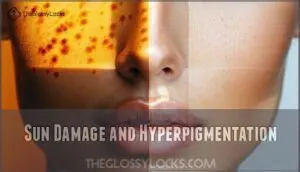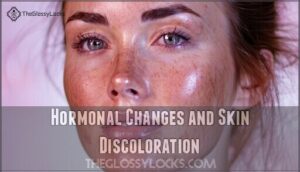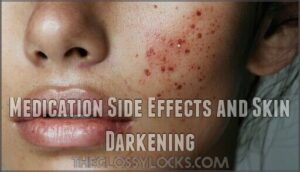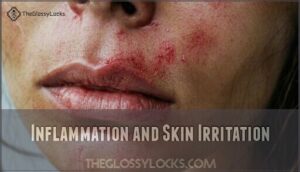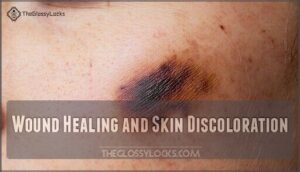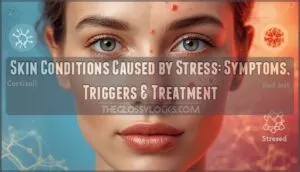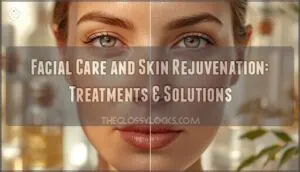This site is supported by our readers. We may earn a commission, at no cost to you, if you purchase through links.
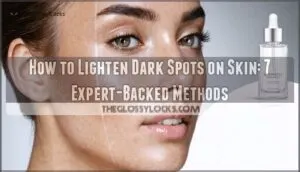 You can effectively lighten dark spots on skin through proven methods ranging from gentle natural remedies to professional treatments.
You can effectively lighten dark spots on skin through proven methods ranging from gentle natural remedies to professional treatments.
Start with topical ingredients like vitamin C, kojic acid, or hydroquinone, which gradually fade pigmentation over weeks to months.
Natural options include aloe vera and green tea extract, though they work slower than medical-grade products.
For stubborn spots, dermatologists offer chemical peels, laser therapy, or IPL treatments that deliver faster results.
Consistent sunscreen use prevents new spots from forming while you’re treating existing ones.
The key is patience—most dark spots didn’t appear overnight, so they won’t disappear that quickly either.
Your specific skin type and spot severity will determine which approach works best for your unique situation, considering the effectiveness of professional treatments.
Table Of Contents
- Key Takeaways
- Causes of Dark Spots
- Lighten Dark Spots Fast
- Natural Remedies Work
- Medical Treatments Available
- Frequently Asked Questions (FAQs)
- How to instantly lighten dark spots?
- How can I fade dark spots in 3 days?
- Does anything really fade dark spots?
- What is the fastest way to fade dark spots?
- Can dark spots on skin be lightened?
- What lightens dark spots the fastest?
- Can dark spots be removed naturally?
- How long does it take for dark spots to fade?
- Can dark spots be prevented from reappearing?
- What are the risks and side effects of dark spot treatments?
- Conclusion
Key Takeaways
- You’ll see the fastest results with professional treatments – Chemical peels, laser therapy, and IPL can show improvement within weeks, while topical treatments need months to work effectively.
- Consistency beats intensity when treating dark spots – Stick with one proven method, like vitamin C or hydroquinone, for 6-12 weeks before switching, as your skin needs time to respond properly.
- Sun protection prevents new spots while you’re treating existing ones – Daily SPF 30+ sunscreen is non-negotiable, since UV exposure can undo months of treatment progress instantly.
- You can combine gentle approaches for better results – Layer vitamin C serums with retinoids or pair natural remedies, like aloe vera, with medical treatments, but introduce new ingredients gradually to avoid irritation.
Causes of Dark Spots
Your skin develops dark spots when melanocytes produce too much melanin in response to triggers like sun exposure, hormonal changes, inflammation, or injuries.
Understanding what’s causing your specific dark spots helps you choose the most effective treatment approach.
Sun Damage and Hyperpigmentation
Everyone knows UV exposure triggers melanin production, leading to those stubborn sun spots and skin discoloration.
Your skin overproduces pigment as protection, creating photodamage that worsens over time.
Prevention beats reversal—daily sunscreen with SPF 30+ blocks harmful rays.
Think of hyperpigmentation as your skin’s overenthusiastic bodyguard, working overtime when UV light hits.
Consistent SPF importance can’t be overstated for sunspots prevention.
Hormonal Changes and Skin Discoloration
Fluctuating hormones during pregnancy, menopause, or contraceptive use can trigger melasma, creating stubborn dark patches on your face.
These endocrine disorders basically tell your melanocytes to work overtime, producing excess pigment that appears as blotchy discoloration.
Pregnancy effects are so common that melasma’s nicknamed "the mask of pregnancy." Hormone replacement therapy and contraceptive influence can similarly spark hyperpigmentation that persists long after treatment ends.
Medication Side Effects and Skin Darkening
Certain prescription drugs can trigger dark spots through Drug-Induced Hyperpigmentation, affecting melanin production and creating lasting discoloration.
While some medications increase Photosensitivity Risks, others deposit pigmented compounds directly into your skin tissue.
Common culprits include:
- Antimalarial drugs (chloroquine) – cause hyperpigmentation in 25% of long-term users
- Minocycline antibiotic – creates blue-grey spots in 3-15% of acne patients
- Chemotherapy agents – trigger diffuse skin darkening post-treatment
- Heart medications (amiodarone) – produce slate-gray pigmentation in sun-exposed areas
These Discoloration Mechanisms involve drug-melanin complexes forming permanent deposits.
Treatment Strategies focus on discontinuation and topical hydrocortisone for inflammation management.
Inflammation and Skin Irritation
When your skin faces inflammation from conditions like acne or eczema, it triggers post-inflammatory hyperpigmentation (PIH).
Breaking down acne and eczema flare-ups into permanent dark patches—your skin’s inflammatory response never forgets.
This skin inflammation activates melanocytes, causing them to overproduce pigment.
Managing skin sensitivity through gentle skincare prevents irritation that leads to scarring, and proper inflammation control is key to preventing further issues.
Irritation management and control are crucial for PIH prevention and scarring reduction.
Wound Healing and Skin Discoloration
When you injure your skin, the healing process itself can trigger discoloration.
Cuts, scratches, or acne create inflammation that stimulates melanocytes to produce excess melanin, leading to postinflammatory hyperpigmentation (PIH). This wound healing response disrupts normal skin regeneration patterns, often leaving darker patches behind.
Effective ingredients like retinol can help renew skin cells.
- Scar tissue formation – Healing stages involve collagen production that can alter pigmentation
- Skin cell turnover – Irregular regeneration creates uneven melanin distribution
- Preventative measures – Proper wound care reduces skin scarring and discoloration risks
Lighten Dark Spots Fast
Accelerate your journey to clearer skin by combining multiple hyperpigmentation treatment approaches for rapid results.
You’ll see faster dark spot removal when layering vitamin C serums with hydroquinone, creating a powerful skin brightening duo that tackles pigmentation from different angles.
Treatment combinations work best when you introduce ingredients gradually—start with niacinamide three times weekly, then add retinoids once your skin adapts.
Professional options like chemical peels or laser treatments deliver quicker fade dark spots results than home remedies alone, but they’re pricier investments.
Meanwhile, consistent prevention strategies protect your progress—sunscreen becomes your best friend since UV exposure can undo months of skin lightening efforts.
The key to rapid results isn’t rushing with harsh products, but rather building a strategic routine that addresses hyperpigmentation through multiple pathways while maintaining your skin’s barrier health.
For individual blemishes, consider using a benzoyl peroxide treatment to target acne-causing bacteria.
Natural Remedies Work
If you’re looking to skip harsh chemicals, you can turn to ingredients from your kitchen cabinet that actually work to lighten dark spots.
These natural remedies contain compounds that gently exfoliate skin and inhibit melanin production, though they’ll work slower than prescription treatments.
Apple Cider Vinegar and Acetic Acid
Apple cider vinegar’s acetic acid naturally inhibits melanin production, making it effective for hyperpigmentation treatment.
When diluted properly, ACV benefits include lightening dark spots within 4-6 weeks of twice-daily application.
Always test skin sensitivity first, as undiluted vinegar can burn, and this natural remedy works best for superficial spots rather than deep melasma.
Offering gentle skin lightening through targeted spot treatment is how this remedy is most effective.
Aloe Vera and Aloin for Skin Lightening
While apple cider vinegar offers one natural approach, aloe vera provides a gentler alternative for skin lightening. This succulent contains aloin, which inhibits melanin production to reduce dark spots effectively.
Research findings show aloe vera improved hyperpigmentation in 77% of participants after eight weeks. The aloin concentration naturally occurring in fresh gel provides ideal benefits without harsh side effects.
Application methods and aloe benefits include:
- Apply fresh aloe vera gel twice daily to clean skin
- Test on small skin area first to check for reactions
- Combine with vitamin C serum for enhanced results
- Use consistently for 6-8 weeks to see improvements
Unlike stronger treatments, aloe vera rarely causes irritation, making it suitable for sensitive skin care routines seeking natural remedies. Aloe vera can also provide calming inflammation benefits for irritated skin.
Red Onion Extract for Scar-Lightening
Red onion extract offers surprising benefits for tackling stubborn dark spots, particularly those resulting from skin scars, keloids, and wounds.
This natural remedy contains cepalin, which reduces inflammation and targets excess pigmentation through specific scar reduction mechanisms.
| Study Details | Results |
|---|---|
| 2013 Double-Blind Trial | 25% improvement in dark scar coloration |
| Treatment Duration | 10 weeks of daily application |
| Participant Success Rate | Significant lightening in post-acne marks |
| Side Effects Observed | Minor itching, rarely requiring discontinuation |
| Best Results Seen | Recent hyperpigmentation vs. long-standing spots |
Clinical studies demonstrate onion extract’s effectiveness through quercetin’s role in inhibiting melanin production.
Application methods involve gentle massage twice daily on clean skin.
The extract works particularly well on skin injuries, stretch marks, and post-surgical scars.
While milder than medical treatments, this accessible option provides steady improvement without harsh side effects.
Green Tea Extract and Depigmentation
Green tea extract’s EGCG benefits include disrupting melanin synthesis pathways in skin melanocytes.
The extract concentration matters for clinical trials effectiveness, and animal studies show 30% reduction in UV-induced skin pigmentation with daily application methods.
EGCG’s antioxidants prevent further skin lightening damage from free radicals, and the green tea mechanism works by targeting skin melanin production directly.
This natural approach offers safer alternatives for depigmentation compared to harsh chemicals, with minimal irritation reported, making it a valuable option due to its antioxidants and natural approach.
Black Tea Water and Skin Lightening
Brewing black tea creates a budget-friendly solution packed with Tea Polyphenols that target Melanin Inhibition through skin melanocytes.
The Brewing Technique involves steeping tea for five minutes, then applying cooled liquid twice daily using cotton pads.
These Antioxidant Effects and skin brightening ingredients support skin tone improvement by reducing skin pigmentation naturally through consistent Application Methods targeting skin melanin production.
Medical Treatments Available
When natural remedies aren’t enough to tackle stubborn dark spots, you’ll want to explore professional medical treatments that deliver faster, more dramatic results.
These dermatologist-performed procedures use advanced technology to target pigmentation at deeper skin layers, often showing improvement within weeks rather than months.
Chemical Peels for Skin Resurfacing
Chemical peels use alpha hydroxy acids like glycolic acid and lactic acid to remove damaged skin layers, reducing dark spots by up to 50% per treatment.
Different acid types and peel strength determine recovery time and effectiveness for various skin types.
Key considerations for chemical peels:
- Peel Strength: Superficial peels offer gentle results with minimal downtime, while medium-depth peels provide dramatic improvement but require longer healing
- Acid Types: Glycolic acid penetrates deepest, lactic acid suits sensitive skin, and salicylic acid works well for acne-related pigmentation
- Recovery Time: Expect 2-4 weeks of mild peeling and redness, with deeper peels requiring up to 6 weeks for complete healing
- Risks Involved: Darker skin types face higher hyperpigmentation risk, making professional assessment essential before treatment
This skin resurfacing technique stimulates cellular turnover, revealing fresher, more evenly toned skin underneath the damaged surface layers.
Many people purchase products for a glycolic acid peel for home use.
Microdermabrasion for Dead Skin Removal
Microdermabrasion uses fine crystals or a diamond-tipped wand to remove dead skin cells through gentle exfoliation. This procedure details show 35-45% reduction in surface pigmentation after 4-6 sessions.
Treatment frequency typically involves bi-weekly appointments for ideal skin exfoliation benefits. Most skin types tolerate this procedure well, with minimal downtime required for post-treatment care.
This minimally invasive technique helps with skin texture changes, improving overall skin appearance.
Intense Pulsed Light (IPL) Therapy
IPL therapy uses broad-spectrum light to target various pigment types, achieving up to 70% clearance of sunspots and hyperpigmentation after three treatment sessions.
**IPL targets pigment cells with precision light, delivering impressive 70% spot clearance in just three sessions.
You’ll see average melanin reduction exceeding 60% in treated areas, with mild side effects like temporary redness occurring in less than 15% of cases.
This non-invasive procedure effectively addresses melasma across different skin types, though procedure cost varies by location and sessions needed.
Many factors influence the overall IPL cost, making it essential to consider these when evaluating the effectiveness and cost of IPL therapy for individual cases.
Laser Resurfacing for Skin Renewal
Laser resurfacing offers a powerful approach for stubborn pigmentation that hasn’t responded to other treatments.
Fractional laser resurfacing achieves 60–80% reduction in hyperpigmented spots after two treatments, with ablative lasers like CO2 targeting melanin-rich areas while stimulating collagen production for thorough skin renewal.
- Laser Types: Fractional, CO2, and Er:YAG lasers target melanocytes with varying intensities
- Treatment Cost: Professional laser resurfacing typically ranges from $500-2,000 per session
- Skin Suitability: Requires careful assessment of skin tone to minimize Potential Risks and hyperpigmentation
Cryotherapy for Pigmented Cell Destruction
Cryotherapy freezes dark spots using liquid nitrogen at -196°C, targeting melanocytes that produce pigment.
This cryosurgery technique destroys pigmented cells through controlled freezing, though hypopigmentation effects can leave treated areas lighter than surrounding skin.
| Treatment Aspect | Details |
|---|---|
| Efficacy Rate | 70-90% clearance for small spots |
| Recovery Time | 1-2 weeks for healing |
| Main Risk | Permanent hypopigmentation (15-20%) |
Cryotherapy risks include temporary blistering and potential scarring, making spot freezing most suitable for isolated lesions.
Treatment efficacy depends on lesion size and depth, with smaller spots responding better to this melanin-targeting approach.
Frequently Asked Questions (FAQs)
How to instantly lighten dark spots?
Like a magic eraser that doesn’t exist, you can’t instantly lighten dark spots overnight.
Professional treatments like chemical peels, lasers, and IPL offer the fastest results, typically showing improvement within weeks, not hours.
How can I fade dark spots in 3 days?
Unfortunately, you can’t safely fade dark spots in just 3 days.
Effective treatments like vitamin C serums, hydroquinone, or professional procedures need weeks to months for visible results.
Quick fixes often cause irritation or worsening pigmentation.
Does anything really fade dark spots?
Vitamin C serums achieve spot reduction in 77% of users within 12 weeks, proving effective treatments exist.
You’ll see real results with hydroquinone, retinoids, and professional procedures like chemical peels or lasers targeting melanin production.
What is the fastest way to fade dark spots?
Professional treatments offer the fastest results. Chemical peels, laser therapy, and microdermabrasion can show improvement within weeks, while prescription-strength hydroquinone provides significant lightening in 8-12 weeks with consistent use.
Can dark spots on skin be lightened?
Yes, you can lighten dark spots using topical treatments like vitamin C, hydroquinone, and retinoids, or professional procedures like chemical peels and laser therapy for faster results.
What lightens dark spots the fastest?
Like erasing stubborn ink stains from paper, professional treatments work fastest to lighten dark spots.
Chemical peels, laser therapy, and IPL treatments can show results within weeks, while topical options like hydroquinone require months.
Can dark spots be removed naturally?
Natural remedies like vitamin C, turmeric, and papaya can help fade dark spots, but they work slowly over months. Professional treatments deliver faster, more dramatic results than home remedies alone.
How long does it take for dark spots to fade?
Dark spots typically fade within 6-12 weeks with consistent treatment, though deeper pigmentation may take several months.
Your skin’s natural turnover process gradually lightens spots, but active ingredients accelerate results substantially, and this process is part of the skin’s natural healing mechanism.
Can dark spots be prevented from reappearing?
After Sarah eliminated her melasma through professional treatment, she prevented recurrence by wearing SPF 30+ daily and using vitamin C serum, keeping her skin clear for two years running.
What are the risks and side effects of dark spot treatments?
Common side effects include irritation, redness, dryness, and peeling from topical treatments like hydroquinone or retinoids. Professional procedures risk scarring, burns, or worsening pigmentation, especially on darker skin tones.
Conclusion
Before telegraphs carried news across continents, people waited months to learn how to lighten dark spots on skin effectively.
Today’s treatments work faster than our ancestors imagined, combining science with patience.
You’ve learned seven proven methods, from gentle natural remedies to professional procedures, each targeting pigmentation through different mechanisms.
Remember, consistency beats intensity when treating dark spots.
Choose methods matching your skin type, commit to sun protection, and give treatments adequate time to work before switching approaches.

